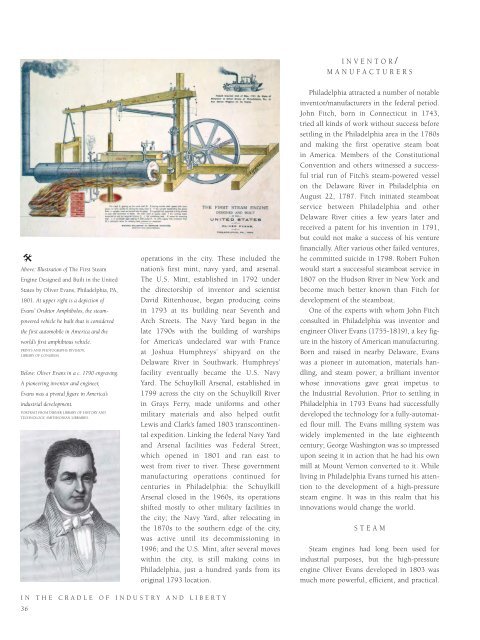In The Cradle of Industry and Liberty
An illustrated history of Philadelphia's manufacturing sector paired with the histories of local companies that make the city great.
An illustrated history of Philadelphia's manufacturing sector paired with the histories of local companies that make the city great.
You also want an ePaper? Increase the reach of your titles
YUMPU automatically turns print PDFs into web optimized ePapers that Google loves.
INVENTOR/<br />
MANUFACTURERS<br />
@<br />
Above: Illustration <strong>of</strong> <strong>The</strong> First Steam<br />
Engine Designed <strong>and</strong> Built in the United<br />
States by Oliver Evans, Philadelphia, PA,<br />
1801. At upper right is a depiction <strong>of</strong><br />
Evans’ Oruktor Amphibolos, the steampowered<br />
vehicle he built that is considered<br />
the first automobile in America <strong>and</strong> the<br />
world’s first amphibious vehicle.<br />
PRINTS AND PHOTOGRAPHS DIVISION,<br />
LIBRARY OF CONGRESS.<br />
Below: Oliver Evans in a c. 1790 engraving.<br />
A pioneering inventor <strong>and</strong> engineer,<br />
Evans was a pivotal figure in America’s<br />
industrial development.<br />
PORTRAIT FROM DIBNER LIBRARY OF HISTORY AND<br />
TECHNOLOGY, SMITHSONIAN LIBRARIES.<br />
operations in the city. <strong>The</strong>se included the<br />
nation’s first mint, navy yard, <strong>and</strong> arsenal.<br />
<strong>The</strong> U.S. Mint, established in 1792 under<br />
the directorship <strong>of</strong> inventor <strong>and</strong> scientist<br />
David Rittenhouse, began producing coins<br />
in 1793 at its building near Seventh <strong>and</strong><br />
Arch Streets. <strong>The</strong> Navy Yard began in the<br />
late 1790s with the building <strong>of</strong> warships<br />
for America’s undeclared war with France<br />
at Joshua Humphreys’ shipyard on the<br />
Delaware River in Southwark. Humphreys’<br />
facility eventually became the U.S. Navy<br />
Yard. <strong>The</strong> Schuylkill Arsenal, established in<br />
1799 across the city on the Schuylkill River<br />
in Grays Ferry, made uniforms <strong>and</strong> other<br />
military materials <strong>and</strong> also helped outfit<br />
Lewis <strong>and</strong> Clark’s famed 1803 transcontinental<br />
expedition. Linking the federal Navy Yard<br />
<strong>and</strong> Arsenal facilities was Federal Street,<br />
which opened in 1801 <strong>and</strong> ran east to<br />
west from river to river. <strong>The</strong>se government<br />
manufacturing operations continued for<br />
centuries in Philadelphia: the Schuylkill<br />
Arsenal closed in the 1960s, its operations<br />
shifted mostly to other military facilities in<br />
the city; the Navy Yard, after relocating in<br />
the 1870s to the southern edge <strong>of</strong> the city,<br />
was active until its decommissioning in<br />
1996; <strong>and</strong> the U.S. Mint, after several moves<br />
within the city, is still making coins in<br />
Philadelphia, just a hundred yards from its<br />
original 1793 location.<br />
Philadelphia attracted a number <strong>of</strong> notable<br />
inventor/manufacturers in the federal period.<br />
John Fitch, born in Connecticut in 1743,<br />
tried all kinds <strong>of</strong> work without success before<br />
settling in the Philadelphia area in the 1780s<br />
<strong>and</strong> making the first operative steam boat<br />
in America. Members <strong>of</strong> the Constitutional<br />
Convention <strong>and</strong> others witnessed a successful<br />
trial run <strong>of</strong> Fitch’s steam-powered vessel<br />
on the Delaware River in Philadelphia on<br />
August 22, 1787. Fitch initiated steamboat<br />
service between Philadelphia <strong>and</strong> other<br />
Delaware River cities a few years later <strong>and</strong><br />
received a patent for his invention in 1791,<br />
but could not make a success <strong>of</strong> his venture<br />
financially. After various other failed ventures,<br />
he committed suicide in 1798. Robert Fulton<br />
would start a successful steamboat service in<br />
1807 on the Hudson River in New York <strong>and</strong><br />
become much better known than Fitch for<br />
development <strong>of</strong> the steamboat.<br />
One <strong>of</strong> the experts with whom John Fitch<br />
consulted in Philadelphia was inventor <strong>and</strong><br />
engineer Oliver Evans (1755-1819), a key figure<br />
in the history <strong>of</strong> American manufacturing.<br />
Born <strong>and</strong> raised in nearby Delaware, Evans<br />
was a pioneer in automation, materials h<strong>and</strong>ling,<br />
<strong>and</strong> steam power; a brilliant inventor<br />
whose innovations gave great impetus to<br />
the <strong>In</strong>dustrial Revolution. Prior to settling in<br />
Philadelphia in 1793 Evans had successfully<br />
developed the technology for a fully-automated<br />
flour mill. <strong>The</strong> Evans milling system was<br />
widely implemented in the late eighteenth<br />
century; George Washington was so impressed<br />
upon seeing it in action that he had his own<br />
mill at Mount Vernon converted to it. While<br />
living in Philadelphia Evans turned his attention<br />
to the development <strong>of</strong> a high-pressure<br />
steam engine. It was in this realm that his<br />
innovations would change the world.<br />
STEAM<br />
Steam engines had long been used for<br />
industrial purposes, but the high-pressure<br />
engine Oliver Evans developed in 1803 was<br />
much more powerful, efficient, <strong>and</strong> practical.<br />
IN THE CRADLE OF INDUSTRY AND LIBERTY<br />
36
















